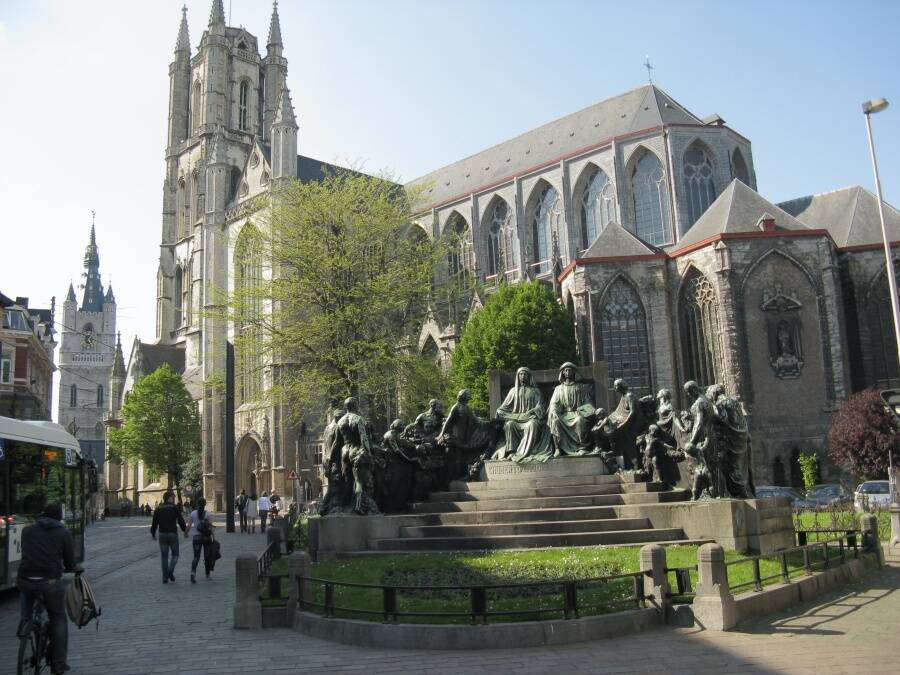The macabre structure was found during work on a new visitor's center for the 700-year-old Saint Bavo's Cathedral.

Ruben WillaertA wall made out of 500-year-old human remains was discovered under a cathedral in Belgium.
When archaeologists recently dug inside and around the historic Saint Bavo’s cathedral in Ghent, Belgium, they found a grisly sight: a wall made out of human bones.
According to The Brussels Times, the skeleton wall was discovered during construction work for a new visitor’s center at the cathedral. Experts estimated that the macabre structure was built sometime during the 17th or 18th century. But the bones may have already been about 200 years old by the time that they were used to create the wall.
The wall was constructed primarily with thigh and shin bones of adults. Mature skulls were also found within the construction. Some skulls were shattered and placed between other bones to fill in spaces.
“This is a phenomenon we’ve not yet come across here,” said Janiek De Gryse, the excavation project’s leader. Archaeologists believe the bones were sourced from an old graveyard near the church. The skeletal structure was low enough that full human skeletons had already been discovered on the ground level above the wall.

WIkimedia CommonsSaint Bavo’s Cathedral stands on the site of 10th-century church as well as a 12th-century church.
This suggests that the wall was built when the graveyard was still in use, leading experts to believe that people were perhaps making space for new burials in the graveyard. But in order to make more room for new burials, they had to get creative with the old bones.
“When clearing a churchyard, the skeletons cannot just be thrown away,” De Gryse explained. “Given that the faithful believed in a resurrection of the body, the bones were considered the most important part.”
The religious belief that skeletal remains were not allowed to be disposed also led to the common practice of building stone houses against the walls of town graveyards so that the houses — known as ossuaries — could act as a storage space for bones if needed.
The snaking network of the Catacombs in Paris (which holds the skeletal remains of more than 6 million people) and the basement ossuary at St. Leonard’s Church in the United Kingdom (which contains the remains of about 4,000 people) are among the world’s largest and most well-preserved collections of human bones.
But in the case of the dig in Ghent, instead of being hidden away, the bones were used to create an entirely new wall structure.
According to a newsletter sent out by the excavation team, there were no children’s bones found to be used for the wall’s construction. Not a surprise, the team wrote, as children’s bones would’ve been too fragile to use as material. Furthermore, back then children’s graves received much less attention than those of adults.
The team also explained that the structure consisted of mostly thigh and shin bones, likely due to a lack of time during collection of the bones.

Saint Bavo’s CathedralThe Mystic Lamb painting, located within the church.
“When clearing graves, people often hurried and did not bother collecting smaller or fragile bones such as vertebrae, ribs, bones from hands and feet,” the team wrote. “So a selection of skulls and long bones emerged.”
Saint Bavo’s is located in Ghent, which is about 31 miles northwest of Brussels. Before the current cathedral’s construction in the 15th and 16th centuries, the site was originally occupied by the site of a 10th-century church and then a 12th-century Romanesque church.
So there’s clearly a lot of history — and apparently bones — to be uncovered at such a remarkable location.
Unlike the famous French Catacombs, which is now a popular tourist attraction, the bones found underneath the Saint Bavo’s Cathedral will be removed for further analysis.
After reading about the wall made of 500-year-old bones discovered in Belgium, learn about the bones of St. Peter that were found inside a 1,000-year-old church. Then find out why babies in ancient Ecuador were buried with helmets made from skulls of other children.





